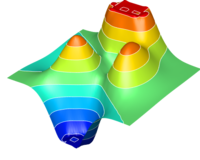SimplexNumerica
| SimplexNumerica (Data Professional)
|
|
|---|---|

|
|
| Basic data
|
|
| developer | Ralf Wirtz |
| Publishing year | 1986 |
| Current version | V17 |
| operating system | Microsoft Windows |
| http://www.simplexnumerica.com | |
SimplexNumerica is a free scientific-technical data analysis and presentation software, developed by Dipl.-Phys.-Ing. Ralf Wirtz and optimized for Microsoft Windows 10 . The program is available in German and English. It offers extensive numerical approximation and interpolation algorithms as well as data analyzes (FFT, DSP, FIR / IIR filters, etc.). The graphics consist of vectorized visualizations (chart / shapes objects) based on a high-resolution 2D / 3D graphics engine (called SimplexGraphics).
The program already has a long history behind it, which began in 1986 at the German Fraunhofer Institute for Laser Technology in Aachen. In the previous version, the program is still known as Data Professional for PC and Atari.
Literature excerpts
In the c't magazine for computer technology 6/2013 (see category literature) several programs from different areas of science and technology were described. Only Origin , Simplexety and SimplexNumerica were listed as evaluation programs . Simplexety and SimplexNumerica come from the same developer. Here is an excerpt from the article:
- The evaluation and presentation of scientific data is one of the more tedious researcher's duties. The remedy here is SimplexNumerica, an easy-to-use plot program. In addition to a large number of predefined 2D and 3D diagrams, the software shines with functions for importing and editing measurement data. The object-oriented structure of the graphic display and a C ++ script language ensure that hardly anything is left to be desired when adapting to your own needs.
Here is an excerpt from the c't magazine 14/2001, an article specifically about SimplexNumerica (see literature section):
- Wherever numerical values arise, for example in measurements in physics lessons, in climate observations for geography or in the context of any statistical investigations, they should be presented in a meaningful way. A very complex and powerful visualization tool that is almost a shame as a mere teaching aid is called SimplexNumerica. The program has a venerable family tree: the Atari ST's predecessor was sold years ago under the name 'Data Professional'. It masters special representations for the most diverse areas in school and study: geographers, biologists, chemists and electrical engineers can use it equally sensibly. The list of algorithms and functions, diagram types and labeling options leave just as little to be desired as the options for the visual design of the results.
Here is the conclusion from ST Computer 6/92 (see literature section):
- The DATA program is highly recommended for professional use when evaluating and presenting larger amounts of data as well as for occasional use, e.g. during studies for evaluating internship attempts or the thesis. The program impresses with both its ease of use and its high working speed. I didn't find any major weaknesses. Nevertheless, a table generator, 3D graphics and perhaps also pie charts would round off the program (note: has been implemented over the years). In closing, I think I can say that DATA has now become a benchmark against which programs of this kind have to be oriented.
Here is the conclusion from the c't magazine 07/1990 (see literature section):
- ... is a professional program that allows very extensive mathematical data evaluations. The additional options give you a wide variety of options for both the mathematical functions and the graphical representation. The program was easy to work with on the Atari. ... it is very positive that the author himself works intensively with his program and that it is continuously expanded and improved and is always open to suggestions from users. ... some suggestions for improvement concern the otherwise very detailed manual. On the one hand, the inclusion of additional application examples and the introduction of an index would be desirable ... for the graphic representation, a 3D graphic would be an advantage, but the author has already thought about this himself ...
Here is the conclusion from ST Computer 4/89 (see literature section):
- ... but the open ear of the author (note: developer) for suggestions for improvement is gratifying. DATA (note: old name for SimplexNumerica) makes an all-round successful impression. It makes it possible to graphically represent measured values in a professional manner, and that's exactly what it's made for. ... has succeeded in establishing a standard by which other programs of this type will have to be measured.
literature
- c't magazine for computer technology, issue 6 of March 2013, pages 140 - 146 title: Software for science and technology (editorial comparison report)
- c't magazine for computer technology, issue 14 from 2001, page 124 title: Understanding with fun, learning and training aids from free and shareware
- ST Computer, Issue 6 from June 1992, pages 50 - 55 Title: What makes an evaluation (editorial report only via Data Professional / SimplexNumerica)
- c't magazine for computer technology, issue 7 from July 1990, page 150 - 156 Title: Approaches from Dr. Nicoletta Adams (Editorial report only via Data Professional / SimplexNumerica)
- ST Computer, Issue 4 from April 1989, Pages 26 - 31 Title: A measured value rarely comes alone (editorial report only via Data Professional / SimplexNumerica)